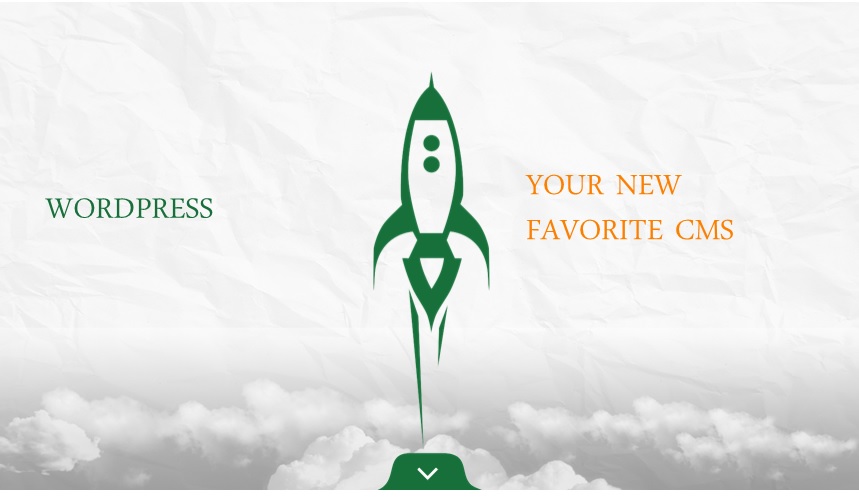WordPress will surely be Your New Favorite CMS if you give it a chance! Download the slides from Rebecca’s WordCamp Kansas City presentation for brand new beginners by clicking on that link.
The presentation goes over some of the basic terminology and concepts — it can be hard to understand WordCamp presentations or WordPress tutorials if you’re confused about the basics.
It also looks at a couple of key pieces of information about how WordPress works.
One important thing to know about WordPress is that your content is pulled into the page from posts and feeds. It basically lives somewhere other than on the page where visitors see it. A traditional HMTL and CSS website is made up of pages which have both design and content. A WordPress website essentially keeps the content separate from the design.
This means that you can change your design without affecting your content.
It can also mean that it can be hard to find things and change them. Unless you have a very simple theme for your website, you won’t just click on “Edit Page” and find everything in one place.
WordPress.com vs. WordPress.org
WordPress.com is a free blogging platform. It’s a great place to have a personal blog, since you don’t have to pay for hosting. There are some disadvantages that make it a bad place for business websites, including the fact that WordPress.com can put ads on your website. You can use themes and widgets, but you can’t use plugins and you can’t use custom themes.
WordPress.org is the home of free, open source software that makes a terrific content management system (CMS) for business websites. You install it at your own website on your own domain using a hosting company like WP Engine and use the software to create your own website with themes, templates, plugins, widgets, and any custom code you choose.
We recommend WordPress.org, but we’re not opposed to WordPress.com. Here’s a nice WordPress.com blog we set up for a company. It links to their website, which isn’t set up for a blog, and it’s a nice blog. It took us a couple of hours start to finish. That’s the beauty of WordPress.com.
Posts and Pages
Posts and pages are very similar when you’re building them. Adding a Page is just as easy as adding a Post. If you mix them up, though, you can end up with a very tangled site architecture. Pages are for things like your About Us page, your Contact page, or your Gallery — things you want to show in your main navigation and keep visible on the site over the long term. They’re also good for landing pages and sales pages, which may not be in your navigation at all.
Posts are for blog posts, which can bring you good traffic for years but which are visible on the main page just until they’re replaced by something new, or for events and frequently-changing products. You keep them on your website, but they won’t be on the main pages forever.
Themes and Templates
Your theme is your design. It will determine the colors, the fonts you use, and where everything ends up on your page. Each theme might have several different templates. For example, the custom theme for Puerto Rico Report has a special blog page which does not look the same as the home page. It has the same colors and fonts, and a very similar feeling, but it is not the same.
Some themes may have only one template, while others may have many. This website, for example, has eight templates. If I put the same content into a page and save it with one template, I will get one look; if I go back and make no other changes but save it with a different template setting, I will get a completely different look.
This is a completely custom theme built for Haden Interactive by Tom Hapgood; you probably won’t find a “Rebelmouse full width” template in any theme you buy ready-made. However, you should make sure that any theme you choose or commission has all the templates you personally need.
Widgets and Plugins
Widgets are pieces of code that you can put into widget areas in your theme. Different themes have different widget areas; usually they’re sidebars, headers, or footers. Here’s a selection of the widget areas for the website where you are right now:
Chances are you won’t have a Julianne Sidebar, but themes can have many different widget areas. Here’s another screenshot showing the widget areas for another custom theme:
Plugins are different from widgets because they can affect the entire website, not just a specific area. Some popular plugins include Akismet, which battles comment spam, Yoast SEO, which helps you keep your website optimized, and WooCommerce, which adds ecommerce to the website. As you can see, there’s an enormous range of plugins. They can be very small pieces of code that do just one small thing, or very robust pieces of software that do big things. Tens of thousands of plugins are free, but there are also plenty of premium plugins.
Now that you have the basic concepts and terminology, you’re ready to talk about WordPress with your web designers and understand what they’re saying.












Leave a Reply